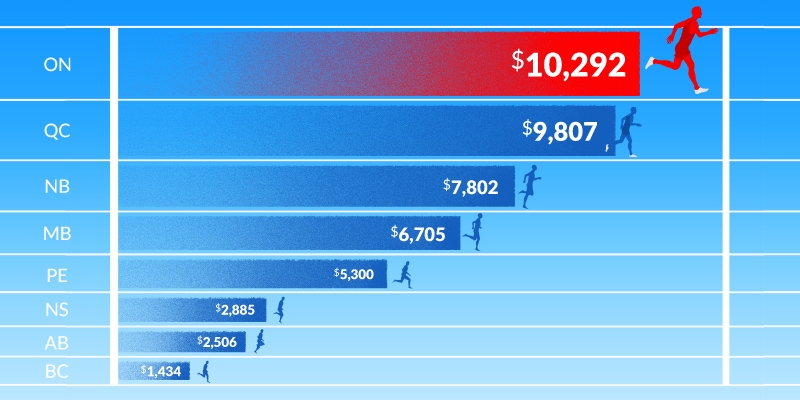Debt Accumulation in Ontario Compared to Other Provinces

A recent Fraser Institute study showed that Ontario’s provincial government has accumulated debt rapidly in recent years. In fact, Ontario has acquired more than half of its nearly $300 billion net debt (a measure that adjusts for financial assets) since 2003/04.
This report builds on that analysis by comparing Ontario’s debt accumulation relative to the other Canadian provinces over the same period. Although several Canadian provinces have experienced mounting fiscal pressure and rising debt levels since 2003/04, none have accumulated new debt at a rate comparable to Ontario.
Ontario has run, on average and after accounting for population differences, substantially larger budget deficits than any other province during this period and, partly as a result, Ontario’s net debt has expanded at a much faster pace.
In 2003/04, the baseline year for our analysis, Ontario’s debt burden (27.2 percent of GDP) was substantial, but ranked in the bottom half among the provinces. In fact, Ontario was the seventh most indebted province relative to GDP in 2003/04. Of the nine provinces in a net debt position, only Saskatchewan and British Columbia maintained lower debt burdens than Ontario that year.
However, in 2003/04, Ontario ran a budget deficit of $5.5 billion, and the province began to acquire significant additional net debt.
Between 2003/04 and 2015/16, Ontario’s debt level increased by more than any other province. Over this time, Ontario’s net debt rose by $10,292 per person, the largest per capita increase in Canada. Quebec experienced the second largest increase; in that province net debt per person increased by $9,807. New Brunswick had the third largest increase at $7,802 per capita.
An examination of increases in net debt relative to the size of the provincial economies tells the same story. Ontario’s net debt increased by 12.6 percentage points (the largest increase of any province) and now stands at 39.9 percent. Quebec and New Brunswick increased their debt burdens relative to GDP by 11.8 and 8.9 percentage points, respectively. Alberta, Manitoba, and Prince Edward Island saw much smaller deteriorations in their financial positions measured in this way, while British Columbia, Nova Scotia, Saskatchewan, and Newfoundland & Labrador saw their economies grow faster than the increase in net debt.
During this period, Ontario’s net debt-to-GDP ratio grew from 27.3 percent to 39.9 percent. This represents a 46.4 percent increase in the province’s net debt-to-GDP ratio, by far the largest increase in Canada since 2003/04.
As a result of Ontario’s singularly rapid rate of debt accumulation, Ontario went from being the seventh most indebted province in terms of net debt relative to GDP in 2003/04, to being the second most indebted province using this metric in 2015/16.
As Ontario’s debt burden has increased faster than other provinces, its share of all provincial debt in Canada has grown. In 2003/04, Ontario held 45.1 percent of provincial net debt in Canada. In 2015/16, that share had climbed to 50.3 percent.
Today, only Quebec currently carries a larger debt burden measured as a percentage of its provincial economy. While Quebec’s debt burden is larger than Ontario’s (measured both against its provincial economy and population), the gaps are closing. Net debt relative to GDP in the two provinces continues to converge, and Ontario’s per person net debt is quickly approaching Quebec’s level. In fact, according to government projections, Ontario’s per-person debt level will surpass Quebec’s by 2017/18. Government projections suggest that it will take longer for Ontario to catch up to Quebec in terms of net debt as a share of GDP, but according to that metric as well, the gap between the two provinces is shrinking.



